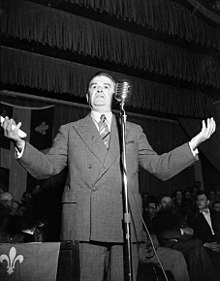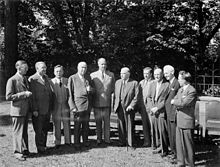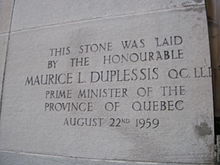Informatics Educational Institutions & Programs
Contents
Maurice Duplessis | |
|---|---|
 Duplessis campaigning in the 1952 election | |
| 16th Premier of Quebec | |
| In office August 30, 1944 – September 7, 1959 | |
| Monarchs | George VI Elizabeth II |
| Lieutenant Governor | Eugène Fiset Gaspard Fauteux Onésime Gagnon |
| Preceded by | Adélard Godbout |
| Succeeded by | Paul Sauvé |
| In office August 17, 1936 – November 8, 1939 | |
| Monarchs | Edward VIII George VI |
| Lieutenant Governor | Ésioff-Léon Patenaude |
| Preceded by | Adélard Godbout |
| Succeeded by | Adélard Godbout |
| MNA for Trois-Rivières | |
| In office February 5, 1923 – September 7, 1959 | |
| Preceded by | Louis-Philippe Mercier |
| Succeeded by | Yves Gabias |
| Personal details | |
| Born | Maurice Le Noblet Duplessis April 20, 1890 Trois-Rivières, Quebec, Canada |
| Died | September 7, 1959 (aged 69) Schefferville, Quebec, Canada |
| Political party | Union Nationale |
| Other political affiliations | Conservative Party of Quebec (pre 1936) |
| Profession | Lawyer |
| This article is part of a series on |
| Conservatism in Canada |
|---|
 |
| Part of a series on |
| Conservatism |
|---|
 |
| Part of a series on |
| Christian democracy |
|---|
 |
|
|
Maurice Le Noblet Duplessis QC (French pronunciation: [dyplɛsi]; 20 April 1890 – 7 September 1959) served as the 16th premier of Quebec from 1936 to 1939 and 1944 to 1959. He rose to power after uniting his Conservative party and the breakaway Action liberale nationale progressive faction of the Liberal party of Premier Louis-Alexandre Taschereau, to form a new national-conservative party, the Union Nationale.[1]
His era was later labeled as La Grande Noirceur ("The Great Darkness") by its critics, due to his support of strong Catholic traditions, his support of business leaders vis-a-vis growing labour rights movements, and his strong opposition not only to Communism, but also to secularism, liberalism, modernism, casual clothing, feminism, environmentalism, leftist separatism and other non-conservative and progressive political trends and movements. These trends and movements would influence Quebec politics and society over the following 60 years, starting with the Quiet Revolution of the 1960s under his Liberal successor Jean Lesage.
During the Duplessis time, the Liberal opposition was unsuccessful in challenging Duplessis' power in three elections (1948, 1952 and 1956). He is also the last Quebec Premier to serve over 10 years in consecutive terms.
Duplessis championed rural areas, provincial rights, nationalism, economic development, strong investment in Catholic education, health and anti-Communism, and had a hard stance against trade unions.
Early life
Duplessis was born in Trois-Rivières, the son of Bertha (born Genest) and local politician Nérée Le Noblet Duplessis. He studied at the Séminaire Saint-Joseph de Trois-Rivières, obtained a law degree from Université Laval's Montreal branch (later renamed Université de Montréal) and was admitted to the Barreau du Quebec in 1913. He returned to his home town to practice law until running for public office. He was a life-long bachelor.[2]
Political career


Duplessis first won the seat as a Conservative Party of Quebec candidate in the 1927 Quebec election. In the 1931 election, he was reelected in his seat, but Conservative leader Camillien Houde lost both the election and his own seat. The Conservative caucus chose C. E. Gault (Charles Ernest Gault) to be interim Leader of the Opposition but, after Houde resigned as party leader in 1932, Duplessis won the leadership of the party during the 1933 convention over the only other candidate, Onésime Gagnon.
Two weeks before the 1935 provincial election, he engineered a coalition with Paul Gouin's Action libérale nationale (ALN), a party of dissident reform Liberals and nationalists who had quit the governing Parti libéral du Québec. While he lost that election, Duplessis was soon able to exploit a patronage scandal involving the family of Premier Louis-Alexandre Taschereau to force Taschereau's resignation.
Gouin withdrew his support from Duplessis on June 18, 1936, but the ALN caucus sided with Duplessis and joined with his Conservative caucus to formally merge into the Union Nationale party. Duplessis and the UN won the August 1936 election in a landslide, putting an end to thirty-nine consecutive years of Liberal rule. Duplessis's first government was defeated in the 1939 election, a snap election called by the premier in hopes of exploiting the issue of Canadian participation in World War II.

Duplessis returned as premier in the 1944 election, and held power without serious opposition for the next fifteen years, until his death, winning elections in 1948, 1952 and 1956. He became known simply as le Chef ("the boss").
He was elected to five terms of office in all, the last four of them consecutive. Duplessis remains the last Quebec premier to have won three or more consecutive majority governments. After him, no political party in Quebec elections at the provincial level had won more than two terms of office in a row until the December 2008 victory of Jean Charest's Liberal party, its third consecutive win.
Policies
Duplessis favoured rural areas over city development and introduced various agricultural credits during his first term. He was also noted for meagre investment in social services except education (budget was multiplied by six between 1946-1956[3]) in Catholic schools. Duplessis also opposed military conscription and Canadian involvement in World War II. The Union Nationale often had the active support of the Roman Catholic Church in its political campaigns and employed the slogan Le ciel est bleu; l'enfer est rouge: Heaven is blue (UN); Hell is red (Liberal).[citation needed] In 1936 Duplessis hung the Crucifix in the National Assembly's Blue Room, where it hung until July 2019.[4]
Jehovah's Witnesses and Roncarelli v. Duplessis
Duplessis actively opposed Jehovah's Witnesses, causing The Globe and Mail to comment, "The persecution of the religious sect known as Jehovah’s Witnesses, now going on in Quebec Province with enthusiastic official and judicial sanction, has taken a turn which suggests that the Inquisition has returned to French Canada."[5] In 1943[clarification needed] the Witnesses of the Canadian province of Quebec were continuously arrested up to twice the same day.[6]
Duplessis once used his influence to revoke a liquor licence from one of their members' businesses. In Roncarelli v. Duplessis, the decision of the lower court was upheld by the Supreme Court of Canada, and damages to Roncarelli were increased. Duplessis was ordered to pay $33,123.53 in damages. In his comments, Justice Abbott wrote, "The cancellation of the licence was made solely because of the plaintiff's association with the Witnesses of Jehovah and with the object and purpose of preventing him from continuing to furnish bail for members of that sect." In a 6-3 decision, Duplessis influencing the liquor commission to cancel the license was deemed an improper use of his power.[7]
Death and legacy

Duplessis died in office after a series of strokes he suffered while visiting the Iron Ore Company of Canada in Schefferville in the presence of seven government and company officials on September 7, 1959. Following his death and the subsequent election of a Liberal government under Jean Lesage in 1960, Quebec entered a period later termed the Quiet Revolution (Révolution tranquille), a decisive movement away from the conservative policies of Duplessis and toward a secular social democracy.
Duplessis has not been without his defenders. Conrad Black's 1977 encomium, Duplessis, painted a sympathetic portrait of the man as a transitional figure towards modernism, and the victim of partisan attack and personal malady.[8]
Nevertheless, Duplessis's legacy has been the subject of repeated criticism in the decades since his death. Quebec nationalists dislike his anti-separatist stance, liberals denounce his social conservatism. His critics hold that Duplessis's inherently corrupt patronage politics, his reactionary conservatism, his emphasis on traditional family and religious values, his anachronistic anti-union stance, rural focus and his preservation and promotion of Catholic Church institutions over the development of a secular social infrastructure akin to that underway in most of the postwar West, stunted Quebec's social and economic development by at least a decade.
In response, it has been argued that the notion of the Duplessis "black years" is a myth propagated by all subsequent major political actors in Quebec due to a fundamental aversion to Catholic church-oriented traditionalist patterns of development, with dominant intellectual movements combining various elements of this dislike. However, the counter-argument, that this is an over-simplification which fails to capture the complexities of Quebec politics, society and its economy, has consistently prevailed in public and academic discourse for some time.
Aside from occasional defenders of his anti-Communist and socially conservative views,[9][10] defence of the Duplessis government today comes primarily from traditionalist conservatives (paleoconservatives in North American definition) who view his regime as an essential reaffirmation of traditional values, and as an assertion by democratic means of the basics of church and family life with low social spending and suppression of labour unions.[citation needed]
Richard Jones, an historian specialising in the political and cultural history of Canada and Quebec, summed up Duplessis:
- "The Duplessis regime may well have endured for too long, the Union Nationale leader's traditionalist policies may well have been anachronistic when compared with the relatively modern society that, in many respects, the Quebec of the 1950s had already become."[11]
References
- ^ Black, Conrad M. (2011). "Duplessis, Maurice Le Noblet". The Canadian Encyclopedia, Historica Foundation, Toronto. Retrieved January 31, 2011.
- ^ MICHEL SARRA-BOURNET (2009). "DUPLESSIS, MAURICE LE NOBLET". University of Toronto/Université Laval. Retrieved October 3, 2013.
{{cite web}}: CS1 maint: numeric names: authors list (link) - ^ Bédard, Eric (2013-05-30). History of Quebec For Dummies. John Wiley & Sons. ISBN 9781118439746.
- ^ "Crucifix removed from National Assembly's Blue Room". CBC News. July 9, 2019. Retrieved 2019-07-14.
- ^ Toronto Globe & Mail, December 19, 1946.
- ^ min. 26:36 https://tv.jw.org/#es/mediaitems/VODMoviesDocumentary/pub-ivfa2_x_VIDEO// min. 26:36.
{{cite web}}: Check|url=value (help); Missing or empty|title=(help) - ^ Roncarelli v. Duplessis, 1959-01-27, retrieved 2017-06-19
- ^ Conrad Black, Duplessis, (McLelland & Stewart, 1977)
- ^ Côté, Pauline (2004). "Public Management of Religious Diversity in Canada". In Richardson, James T. (ed.). Regulating religion: case studies from around the globe legacy. Springer. p. 425. ISBN 9780306478864.
- ^ Frost, Catherine (2006). Morality and nationalism. Taylor & Francis. p. 157. ISBN 9780203086179.
- ^ Richard Jones, "Duplessis and the Union National Administration" (Ottawa: Canadian Historical Association, 1983), p. 17. Reproduced on-line by Library and Archives Canada: Canadian Historical Association Booklets.
Further reading
Sources in English
- Black, Conrad, Career of Maurice L. Duplessis as viewed through his correspondence, 1927-1939 (thesis) (Montréal: McGill University, 1973).
- Laporte, Pierre, The True Face of Duplessis (Montreal: Harvest House Limited, 1960).
- Paulin, Marguerite Maurice Duplessis: Powerbroker, Politician (Montreal: XYZ Publishing, 2002).
- Quinn, Herbert F., The Union Nationale: Quebec Nationalism from Duplessis to Levesque (2nd enlarged edition) (Toronto: University of Toronto Press, 1979) ISBN 0-8020-2318-5.
Sources in French
- Arcand, Denys and Pierre Latour (editors), Duplessis (Dialogue from the tv series) (Montréal: VLB Éditeur, 1978).
- Benoît, André, Maurice Duplessis et le duplessisme : bilan historiographique, 1959-1980 (thesis) (Montréal: Université de Montréal, 1983).
- Berthelot, Pierre B., Duplessis est encore en vie (Québec: Éditions du Septentrion, 2021 (ISBN 9782897912239).
- Berthelot, Pierre B., Maurice Duplessis : Mises en récit d'un personnage historique (thesis) (Montréal: Université de Montréal, 2014).
- Black, Conrad (trad. Monique Benoît), Duplessis, t. 1 : L'Ascension (Montréal: Éditions de l'Homme, 1977) (ISBN 0775507091).
- Black, Conrad (trad. Monique Benoît), Duplessis, t. 2 : Le Pouvoir (Montréal: Éditions de l'Homme, 1977) (ISBN 0775905607).
- Boismenu, Gérard, Le duplessisme : politique économique et rapports de force, 1944-1960 (Montréal: Les Presses de l'Université de Montréal, 1981).
- Collectif; Fournier, Louis et al., Histoire du mouvement ouvrier au Quebec. 150 Ans De Luttes (Québec: Coédition CSN/CSQ, 2001).
- Gélinas, Xavier and Lucia Ferretti (directors), Duplessis, son milieu son époque (Québec: Septentrion, 2010) (ISBN 978-2-89448-625-2).
- Hébert, Jacques Duplessis, non merci! (Montréal: Éditions du Boréal, 2000).
- Jasmin, Claude, Le patriarche bleu : Duplessis (Outremont: Lanctôt Éditeur, 1999).
- Laporte, Pierre, Le vrai visage de Duplessis (Ottawa: Éditions de l'Homme, 1960).
- Lavigne, Alain, Duplessis, pièce manquante d’une légende : l'invention du marketing politique (Québec: Septentrion, 2012) (ISBN 978-2-89448-688-7).
- Lemay, Martin À la défense de Maurice Duplessis (Montrél: Éditions Québec Amérique, 2016 (ISBN 9782764430699).
- Lévesque, Michel, and Martin Pelletier, L’Union nationale : bibliographie (Québec: Bibliothèque de l'Assemblée nationale, 2009).
- Livernois, Jonathan, La révolution dans l'ordre : Une histoire du duplessisme (Montréal: Boréal, 2018) (ISBN 9782764625477).
- Marcotte, Gilles, La Mort de Maurice Duplessis (Montréal: Boréal, 1999).
- Maurice Duplessis, grand canadien : biographie du premier ministre de la province de Québec (Montréal: Benallack Press, 1948).
- Paradis, Raymond, Nous avons connu Duplessis (Montréal: Éditions Marie-France, 1977).
- Paulin, Marguerite, Maurice Duplessis (Montreal: XYZ Éditions, 2002).
- Roberts, Leslie (trad. Jean Paré), Le Chef : une biographie politique de Maurice L. Duplessis (Montréal: Éditions du Jour, 1963).
- Rouillard, Jacques. (2004). Le syndicalisme québécois (Montréal: Boreal, 2004).
- Rumilly, Robert, Maurice Duplessis et son temps, t. 1 : 1890-1944 (Montréal: Fides, 1973).
- Rumilly, Robert, Maurice Duplessis et son temps, t. 2 : 1944-1959 (Montréal: Fides, 1973).
- Saint-Aubin, Bernard, Duplessis et son époque (Montréal: La Presse, 1979).
- Trois Rives, Jean des, Maurice Duplessis (Éditions du Château, 1960).
- Vanasse, Claudie, Maurice Duplessis (Montreal: Les Malins, 2008) (ISBN 9782896570102).
External links
- Biography of Maurice Duplessis
- "Biography". Dictionnaire des parlementaires du Québec de 1792 à nos jours (in French). National Assembly of Quebec.
- May 22 1999 Article On Duplessis Archived 2018-12-15 at the Wayback Machine
- CBC Digital Archives - Maurice Duplessis
*The Union Nationale was founded as an alliance in 1935 with Duplessis as leader. In 1936 the UN formally became a unitary political party with the Quebec Conservative Party dissolving into it.

















